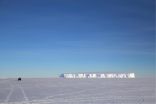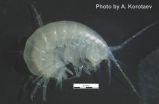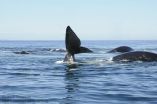INFORMATION:
Two videos:
UNSW's Dr Ezequiel Marzinelli and Dr Graeme Clark drill a hole in the sea-ice in Commonwealth Bay in East Antarctica. https://www.youtube.com/watch?v=7IYwOzth1Uo
An underwater camera is lowered through a hole in the sea ice to the sea floor in Commonwealth Bay in East Antarctica by UNSW scientists. The images reveal disintegrating seaweed and bleached pink coralline algae, plus some small sea stars and brittle stars.
https://www.youtube.com/watch?v=0lj4VAGn_bo
Credit: UNSW
Media contacts:
Dr Graeme Clark: + 612 9385 1711, g.clark@unsw.edu.au
Professor Emma Johnston: + 612 9385 1825, e.johnston@unsw.edu.au
Deborah Smith, UNSW Science media: + 612 9385 7307, + 61 478 492 060, deborah.smith@unsw.edu.au
Beached iceberg helps reveal ecological impact of sea-ice changes
2015-05-18
(Press-News.org) The grounding of a giant iceberg in Antarctica has provided a unique real-life experiment that has revealed the vulnerability of marine ecosystems to sudden changes in sea-ice cover.
UNSW Australia scientists have found that within just three years of the iceberg becoming stuck in Commonwealth Bay - an event which dramatically increased sea-ice cover in the bay - almost all of the seaweed on the sea floor had decomposed, or become discoloured or bleached due to lack of light.
"Understanding the ecological effect of changes in sea-ice is vital for understanding the future impacts of climate change, but it is impossible to manipulate sea-ice at the scale we need to conduct experiments," says the study's lead author, UNSW's Dr Graeme Clark.
"Luckily, the grounding of an iceberg in Commonwealth Bay in 2010 provided us with a perfect natural experiment to carry out research on this important issue.
"Historically, the winds coming down from the Antarctic ice cap have kept the bay free of sea-ice for most of the year. But since the massive iceberg got stuck, the bay has been covered in sea-ice several metres thick, all year round," he says.
The study is published in the journal Polar Biology.
The scientists travelled to Commonwealth Bay in the east of the continent in December 2013, as part of the UNSW-led Australasian Antarctic Expedition 2013-2014, which retraced the route of Sir Douglas Mawson's scientific expedition a century before.
Dr Clark and team member, Dr Ezequiel Marzinelli, drilled through the sea ice in the bay and used underwater cameras to survey the seabed.
The UNSW team, led by Professor Emma Johnston, also examined the historical records made by Sir Douglas Mawson, who established his research station in Commonwealth Bay. Mawson's expedition used dredge hauls to survey the bay, which was then rarely covered in ice, in five locations during a two-year period from 1912 to 1913.
The UNSW researchers also compared their survey results with footage taken in the area in 2008 by underwater photographer Erwan Amice.
"After three years of sea-ice cover, the forests of healthy seaweeds that previously dominated the seabed were in a severe state of decline," says Professor Johnston, of the UNSW School of Biological, Earth and Environmental Sciences.
"About three quarters were decomposing, while the remainder were discoloured or bleached. However, darkness-adapted vertebrates such as brittle stars and fan worms were starting to colonise the bay."
Dr Marzinelli says: "This is the first time a shift from an algae-dominated ecosystem to an invertebrate-dominated one has been observed with a known start date. Continued sampling at the site would allow the rate at which this transition is occurring to be worked out."
Sea-ice not only affects how much light reaches the animals and plants living on the seabed, it regulates the amount of disturbance from drifting icebergs that scour the bottom, and determines the amount of detritus and vegetation that settles there.
ELSE PRESS RELEASES FROM THIS DATE:
Brain learning simulated via electronic replica memory
2015-05-18
Scientists are attempting to mimic the memory and learning functions of neurons found in the human brain. To do so, they investigated the electronic equivalent of the synapse, the bridge, making it possible for neurons to communicate with each other. Specifically, they rely on an electronic circuit simulating neural networks using memory resistors. Such devices, dubbed memristor, are well-suited to the task because they display a resistance, which depends on their past states, thus producing a kind of electronic memory. Hui Zhao from Beijing University of Posts and Telecommunications, ...
New cryptic amphipod discovered in West Caucasus caves
2015-05-18
An international team of scientists have discovered a new species of typhlogammarid amphipod in the limestone karstic caves of Chjalta mountain range -- the southern foothills of the Greater Caucasus Range. The study was published in the open access journal Subterranean Biology.
The new amphipod, which belongs to the genus Zenkevitchia, is the second species known from this group. This new addition to the genus is named Zenkevitchia yakovi after the famous Russian biospeleologist Prof Yakov Birstein.
Typhlogammarid amphipods are a group blind and unpigmented endemic ...
Organic nanoparticles, more lethal to tumors
2015-05-18
Radiotherapy used in cancer treatment is a promising treatment method, albeit rather indiscriminate. Indeed, it affects neighbouring healthy tissues and tumours alike. Researchers have thus been exploring the possibilities of using various radio-sensitizers; these nanoscale entities focus the destructive effects of radiotherapy more specifically on tumour cells. In a study published in EPJ D, physicists have now shown that the production of low-energy electrons by radio-sensitizers made of carbon nanostructures hinges on a key physical mechanism referred to as plasmons ...
New options for spintronic devices: Switching magnetism between 1 and 0 with low voltage near room temperature
2015-05-18
This news release is available in German.
Scientists from Paris and Helmholtz-Zentrum Berlin have been able to switch ferromagnetic domains on and off with low voltage in a structure made of two different ferroic materials. The switching works slightly above room temperature. Their results, which are published online in Scientific Reports, might inspire future applications in low-power spintronics, for instance for fast and efficient data storage.
Information can be written as a sequence of bit digits, i.e. "0" and "1". Materials which display ferromagnetism ...
Researchers quantify proportion of different genetic mutations in individual bowel cancers
2015-05-18
Bowel cancer is often driven by mutations in one of several different genes, and a patient can have a cancer with a different genetic make-up to another patient's cancer. Identifying the molecular alterations involved in each patient's cancer enables doctors to choose drugs that best target specific alterations.
However, it is also becoming clear that while some cancers may be driven by a single gene mutation, individual tumours are often composed of groups of cancer cells, with each group having different molecular alterations from the others. This is known as intra-tumour ...
Scientists discover bacterial cause behind fatal heart complications
2015-05-18
Streptococcus pneumoniae is a major human pathogen and is known to be associated with increased risk of fatal heart complications including heart failure and heart attacks.
As Streptococcus pneumoniae is a respiratory pathogen that does not infect the heart, however, this association with heart problems has puzzled clinicians and researchers, particularly as even prompt use of antibiotics does not provide any protection from cardiac complications.
A multidisciplinary research team, led by Professor Aras Kadioglu and Professor Cheng-Hock Toh at the University of Liverpool, ...
I knew it was you by the sound of your (whale) voice
2015-05-18
WASHINGTON, D.C., May 18, 2015 -- Human beings have unique voices -- from the deep, resonating bass of James Earl Jones to the raspy melodies sung by Broadway star Carol Channing -- and we routinely recognize individuals based solely on the way they sound, for example over the telephone, on a music CD or in an animated film.
The same theory that explains individual differences in human speech has recently been applied to other members of the animal kingdom, including dogs and deer. Now researchers from Syracuse University in New York are working to understand whether ...
Seals threaten Scottish cod stock recovery
2015-05-18
Predatory seals are constraining the recovery of cod stocks in Scottish West coast waters, research led at the University of Strathclyde suggests.
Losses of cod, through fishing and natural causes, have remained high for many years and have caused long-term decline in the stock - in some years, fishing removed around 50% of the total weight of the stock. The study found that, although fishing has now halved, predation by seals has rapidly increased to compensate, eating up more than 40% of the total stock.
Seals have, historically, been anecdotally blamed for the reduction ...
Key strategies can boost donations at crowdfunding sites, Stanford experts say
2015-05-18
Stanford computer scientists have shown how crowdfunding websites can use data science to boost cash value of donations. Their research confirms, among other findings, the importance of a timely thank you.
It's common courtesy to say thanks when receiving a gift, and common sense to think that givers might be generous again if they felt good about their prior gift.
Now Stanford computer scientists have shown how crowdfunding websites like Kickstarter and DonorsChoose.org can use data science to apply these folk wisdoms systematically, and on a large scale, to greatly ...
Substance abuse risk not greater in those using medical marijuana with prescribed opioids
2015-05-18
PISCATAWAY, NJ - Among people who use medical cannabis for chronic pain, those who also take prescription pain medications are not at increased risk for serious alcohol and other drug involvement, according to a study in the May issue of the Journal of Studies on Alcohol and Drugs.
Although medical cannabis is being used increasingly often as an alternative to opioids for chronic pain, in many patients it is being used in conjunction with opioids. This use has raised concerns that the combination could increase the risk of patients using substances such as alcohol and ...



